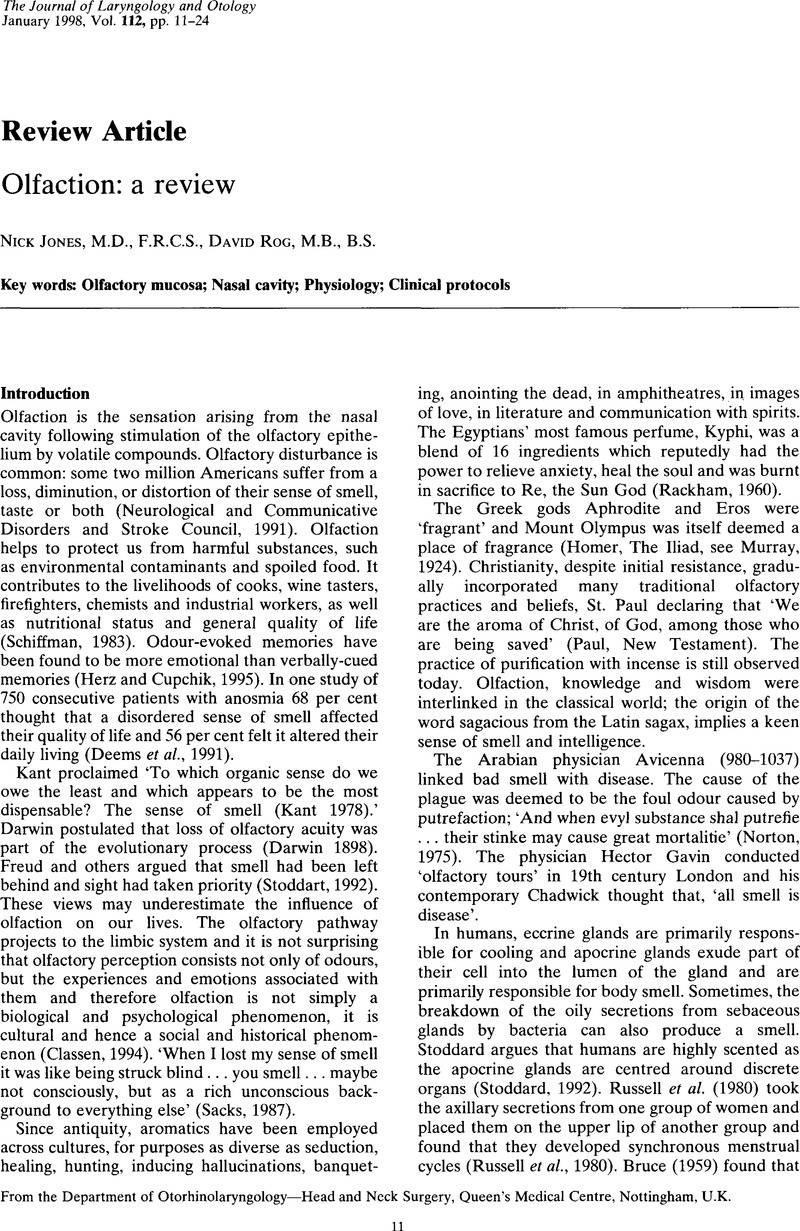Crossref Citations
This article has been cited by the following publications. This list is generated based on data provided by Crossref.
Gong, Siew-Ging
2001.
Characterization of olfactory nerve abnormalities in Twirler mice.
Differentiation,
Vol. 69,
Issue. 1,
p.
58.
Jones, Nick
2001.
The nose and paranasal sinuses physiology and anatomy.
Advanced Drug Delivery Reviews,
Vol. 51,
Issue. 1-3,
p.
5.
Holbrook, Eric H.
DiNardo, Laurence J.
and
Costanzo, Richard M.
2001.
Olfactory Epithelium Grafts in the Cerebral Cortex: An Immunohistochemical Analysis.
The Laryngoscope,
Vol. 111,
Issue. 11,
p.
1964.
Dulay, Mario F.
and
Murphy, Claire
2002.
Olfactory acuity and cognitive function converge in older adulthood: Support for the common cause hypothesis..
Psychology and Aging,
Vol. 17,
Issue. 3,
p.
392.
Brunette, Donald M.
2002.
Introduction to the Proceedings of the Fifth International Conference on Breath Odour Research.
International Dental Journal,
Vol. 52,
Issue. 5,
p.
177.
Aloisi, Anna Maria
Ceccarelli, Ilaria
Masi, Flavio
and
Scaramuzzino, Andrea
2002.
Effects of the essential oil from citrus lemon in male and female rats exposed to a persistent painful stimulation.
Behavioural Brain Research,
Vol. 136,
Issue. 1,
p.
127.
Rouby, Catherine
Schaal, Benoist
Dubois, Danièle
Gervais, Rémi
and
Holley, A.
2002.
Olfaction, Taste, and Cognition.
p.
389.
Hummel, Thomas
Heilmann, Stefan
and
Murphy, Claire
2002.
Olfaction, Taste, and Cognition.
p.
441.
Majumdar, S.
Jones, N. S.
McKerrow, W. S.
and
Scadding, G.
2003.
The Management of Idiopathic Olfactory Hallucinations: A Study of Two Patients.
The Laryngoscope,
Vol. 113,
Issue. 5,
p.
879.
Marie, I.
Mikolajczak, S.
Massy, N.
Thuillez, C.
and
Levesque, H.
2005.
Cacosmie au cours d'un traitement par ésoméprazole.
La Revue de Médecine Interne,
Vol. 26,
Issue. 6,
p.
525.
Pantelis, Christos
and
Brewer, Warrick J.
2006.
Olfaction and the Brain.
p.
259.
Harris, Rebecca
Davidson, Terence M.
Murphy, Claire
Gilbert, Paul E.
and
Chen, Margaret
2006.
Clinical Evaluation and Symptoms of Chemosensory Impairment: One Thousand Consecutive Cases from the Nasal Dysfunction Clinic in San Diego.
American Journal of Rhinology,
Vol. 20,
Issue. 1,
p.
101.
Shetty, Sandeep
Vishwanathan, Harishnath
and
Carrie, Sean
2007.
The management of olfactory disorders.
British Journal of Hospital Medicine,
Vol. 68,
Issue. 5,
p.
241.
McNeill, E
Ramakrishnan, Y
and
Carrie, S
2007.
Diagnosis and management of olfactory disorders: survey of UK-based consultants and literature review.
The Journal of Laryngology & Otology,
Vol. 121,
Issue. 8,
p.
713.
Alfonso Collado, José Ignacio
and
Vallés Varela, Héctor
2008.
Study of Olfactory Function for Pyridine in Healthy Population: Influence of Variations in Humidity.
Acta Otorrinolaringologica (English Edition),
Vol. 59,
Issue. 10,
p.
475.
Alfonso Collado, José Ignacio
and
Vallés Varela, Héctor
2008.
Estudio de la sensibilidad olfativa a la piridina en población sana.
Acta Otorrinolaringológica Española,
Vol. 59,
Issue. 10,
p.
475.
Gilbert, Paul E.
Pirogovsky, Eva
Ferdon, Sally
Brushfield, Andrea M.
and
Murphy, Claire
2008.
Differential Effects of Normal Aging on Memory for Odor-Place and Object-Place Associations.
Experimental Aging Research,
Vol. 34,
Issue. 4,
p.
437.
Lombion, Sandrine
Morand-Villeneuve, Nadège
and
Millot, Jean-Louis
2008.
Effects of anti-depressants on olfactory sensitivity in mice.
Progress in Neuro-Psychopharmacology and Biological Psychiatry,
Vol. 32,
Issue. 3,
p.
629.
Aloisi, A.M.
Ceccarelli, I.
Fiorenzani, P.
and
Bonezzi, C.
2009.
Les différences hommes-femmes dans la perception et la modulation de la douleur.
Douleur et Analgésie,
Vol. 22,
Issue. 3,
p.
140.
Curtis, Maurice A.
Monzo, Hector J.
and
Faull, Richard L.M.
2009.
Neurotherapy: Progress in Restorative Neuroscience and Neurology.
Vol. 175,
Issue. ,
p.
33.



